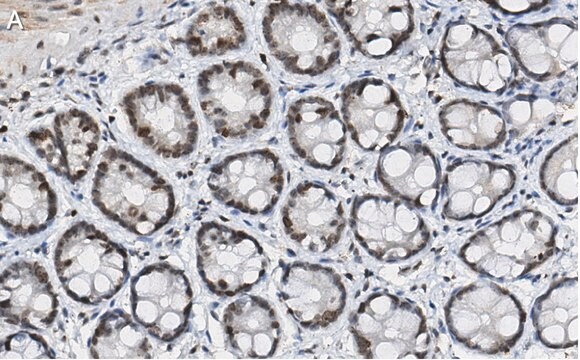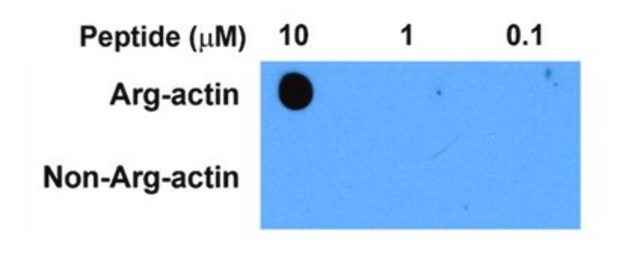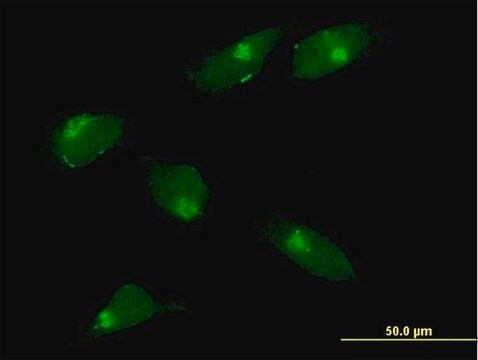추천 제품
생물학적 소스
rat
결합
unconjugated
항체 형태
purified from hybridoma cell culture
항체 생산 유형
primary antibodies
클론
Clone 6F10, monoclonal
형태
buffered aqueous solution
분자량
~21 kDa
종 반응성
mouse, monkey, canine, rat, human
포장
antibody small pack of 25 μL
농도
~1.0 mg/mL
기술
immunocytochemistry: suitable
western blot: 0.12-0.25 μg/mL using A549, HeLa, SH-SY5Y, COS7 or MDCK cell extracts
동형
IgG2b
UniProt 수납 번호
배송 상태
dry ice
저장 온도
−20°C
타겟 번역 후 변형
unmodified
유전자 정보
human ... GLO1(2739)
mouse ... Glo1(109801)
rat ... Glo1(294320)
일반 설명
Monoclonal Anti-Glyoxalase I (rat IgG2b isotype) is derived from the hybridoma 6F10 produced by the fusion of mouse myeloma cells and splenocytes from rat immunized with a mouse Glyoxalase I fusion protein. The glyoxalase system, which consists of glyoxalase I (GLO1), glyoxalase II, and a catalytic amount of reduced glutathione (GSH), is important part of cellular metabolism. GLO1 appears to be ubiquitously expressed in all mammalian cells, suggesting its biological importance.
면역원
mouse Glyoxalase I fusion protein
애플리케이션
Monoclonal Anti-Glyoxalase I antibody produced in rat has been used in immunoblotting. and immunocytochemistry.
생화학적/생리학적 작용
The glyoxalase system plays a major role to detoxify α-ketoaldehydes, especially methylglyoxal (MG), that are endogenously formed as a by-product of the triosephosphate isomerase reaction during glycolysis. A member of this system, GLO1 catalyzes the isomerization of a hemithioacetal, comprised of a nonenzymatic adduct of MG and glutathione (GSH), to the corresponding α-d-hydroxyacid thioester and S-D-lactoylglutathione. Studies have suggested that GLO1 may be important for brain function since, GLO1 in the brain is involved in Alzheimer′s disease, autism, anxiety and the regulation of theta oscillations during sleep.
물리적 형태
Solution in 0.01 M phosphate buffered saline, pH 7.4, containing 15 mM sodium azide
면책조항
Unless otherwise stated in our catalog or other company documentation accompanying the product(s), our products are intended for research use only and are not to be used for any other purpose, which includes but is not limited to, unauthorized commercial uses, in vitro diagnostic uses, ex vivo or in vivo therapeutic uses or any type of consumption or application to humans or animals.
적합한 제품을 찾을 수 없으신가요?
당사의 제품 선택기 도구.을(를) 시도해 보세요.
Storage Class Code
10 - Combustible liquids
Flash Point (°F)
Not applicable
Flash Point (°C)
Not applicable
시험 성적서(COA)
제품의 로트/배치 번호를 입력하여 시험 성적서(COA)을 검색하십시오. 로트 및 배치 번호는 제품 라벨에 있는 ‘로트’ 또는 ‘배치’라는 용어 뒤에서 찾을 수 있습니다.
Proteomic identification and characterization of hepatic glyoxalase 1 dysregulation in non-alcoholic fatty liver disease
Spanos C, et al.
Proteome Science, 16(1), 4-4 (2018)
Tumor necrosis factor-induced modulation of glyoxalase I activities through phosphorylation by PKA results in cell death and is accompanied by the formation of a specific methylglyoxal-derived AGE
Van Herreweghe F, et al.
Proceedings of the National Academy of Sciences of the USA, 99(2), 949-954 (2002)
Methylglyoxal: an emerging signaling molecule in plant abiotic stress responses and tolerance
Hoque TS, et al.
Frontiers in Plant Science, 7(20), 1341-1341 (2016)
Christos Spanos et al.
Proteome science, 16, 4-4 (2018-02-20)
Non-alcoholic fatty liver disease (NAFLD) is the most common liver disease worldwide. However, its molecular pathogenesis is incompletely characterized and clinical biomarkers remain scarce. The aims of these experiments were to identify and characterize liver protein alterations in an animal
Proteomic studies identified a single nucleotide polymorphism in glyoxalase I as autism susceptibility factor
Junaid MA, et al.
American Journal of Medical Genetics. Part A, 131(1), 11-17 (2004)
자사의 과학자팀은 생명 과학, 재료 과학, 화학 합성, 크로마토그래피, 분석 및 기타 많은 영역을 포함한 모든 과학 분야에 경험이 있습니다..
고객지원팀으로 연락바랍니다.







